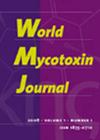在撒哈拉以南非洲建立黄曲霉毒素预测风险模型的潜力:综述
IF 1.7
4区 医学
Q3 FOOD SCIENCE & TECHNOLOGY
引用次数: 6
摘要
这篇综述介绍了黄曲霉毒素风险预测模型的现状及其对撒哈拉以南非洲整个食物链价值参与者的潜力,重点是改善小农户的管理做法。包括澳大利亚、美国和南欧在内的高收入国家的学术研究或私营部门聚合商和加工商已经开发了一些经验和机制模型,但这些模型在撒哈拉以南非洲的应用程度很低,由于气候变化,这些国家的潜力很大,需求也在增加。可以使用黄曲霉毒素积累的机制微生物学框架或基于与气候条件和当地农艺因素的统计相关性的经验模型,根据历史发生数据进行预测。然后,模型结果可以通过私人、公共或移动推广服务分发给小农户,供决策者用于战略或政策,或供私营部门机构用于管理决策。具体的农业建议可以在酚学周期的三个最关键点提供:季前洞察,包括播种时间和作物品种,采前管理和收获时间建议,以及采后最佳实践,包括储存、干燥和市场信息。撒哈拉以南非洲的模型开发受到缺乏地理参考黄曲霉毒素发生数据和实时高分辨率气候数据的限制;农场类型多样,每种类型都存在重大的信息和技术差距;非正规市场结构盛行,缺乏经济激励制度;以及普遍缺乏对黄曲霉毒素的认识和减轻风险的最佳管理做法。鉴于在解决这些挑战方面取得的进展,黄曲霉毒素预测模型可以集成到决策支持平台中,通过最大限度地减少产量和营养损失,专注于优化小农户的价值,这可以在整个生产和采后阶段传播价值。本文章由计算机程序翻译,如有差异,请以英文原文为准。
The potential for aflatoxin predictive risk modelling in sub-Saharan Africa: a review
This review presents the current state of aflatoxin risk prediction models and their potential for value actors throughout the food chain in sub-Saharan Africa, with a specific focus on improving smallholder farmer management practices. Several empirical and mechanistic models have been developed either in academic research or by private sector aggregators and processors in high-income countries including Australia, the USA, and Southern Europe, but these models have been only minimally applied in sub-Saharan Africa, where there is significant potential and increasing need due to climate variability. Predictions can be made based on historic occurrence data using either a mechanistic microbiological framework for aflatoxin accumulation or an empirical model based on statistical correlations with climate conditions and local agronomic factors. Model results can then be distributed to smallholders through private, public, or mobile extension services, used by policymakers for strategy or policy, or utilised by private sector institutions for management decisions. Specific agricultural advice can be given during the three most critical points in the phenological cycle: preseason insight including sowing timing and crop varieties, preharvest advice about management and harvest timing, and postharvest optimal practices including storage, drying, and market information. Model development for sub-Saharan Africa is limited by a dearth of georeferenced aflatoxin occurrence data and real-time high resolution climate data; the wide diversity of farm typologies each with significant information and technology gaps; a prevalence of informal market structures and lack of economic incentives systems; and general lack of awareness around aflatoxins and best management practices to mitigate risk. Given advancements towards solving these challenges, predictive aflatoxin models can be integrated into decision support platforms to focus on optimisation of value for smallholders by minimising yield and nutritional losses, which can propagate value throughout the production and postharvest phases.
求助全文
通过发布文献求助,成功后即可免费获取论文全文。
去求助
来源期刊

World Mycotoxin Journal
MYCOLOGY-
CiteScore
4.60
自引率
5.00%
发文量
25
审稿时长
>12 weeks
期刊介绍:
''World Mycotoxin Journal'' is a peer-reviewed scientific journal with only one specific area of focus: the promotion of the science of mycotoxins. The journal contains original research papers and critical reviews in all areas dealing with mycotoxins, together with opinions, a calendar of forthcoming mycotoxin-related events and book reviews. The journal takes a multidisciplinary approach, and it focuses on a broad spectrum of issues, including toxicology, risk assessment, worldwide occurrence, modelling and prediction of toxin formation, genomics, molecular biology for control of mycotoxigenic fungi, pre-and post-harvest prevention and control, sampling, analytical methodology and quality assurance, food technology, economics and regulatory issues. ''World Mycotoxin Journal'' is intended to serve the needs of researchers and professionals from the scientific community and industry, as well as of policy makers and regulators.
 求助内容:
求助内容: 应助结果提醒方式:
应助结果提醒方式:


